  |
|
|
CHAPTER 5
Uncertainty and Complexity
Uncertainty
Two types of
uncertainty1 are considered:
- Type 1 Uncertainty. This is uncertainty about the truth of the input evidences.
- Type 2 Uncertainty. This is uncertainty about the validity of the rules.
To deal with the first type, we can analyze the impact of varying the input
probabilities, over possible or plausible ranges, on the probabilities of the conclusions.
To deal with the second type, we can investigate the impact of varying both the sensitivity
and the specificity of the rules on the conclusions.
Each rule has one conclusion and a combination of input evidences. The validity
of each rule can be specified by two parameters:
- The sensitivity of the rule. This is the conditional probability P(C|E) that the conclusion is true when the rule's combined
evidences are true. In the simulations that follow, P(C|E)
is varied from 0% to 100% in steps of 5%.
- The specificity of the rule. This is the conditional probability P(-C|-E) that the conclusion is false when the rule's combined
evidences are false. P(C|-E), the conditional probability
that the conclusion is true when the rule's combined evidences are false, is
equal to 1-P(-C|-E). In the following simulations, P(C|-E), is varied from 0% to 50% in steps of 10%.
For a rule to be absolutely valid, P(C|E) and P(C|-E) must be equal to 100% and 0%, respectively.
The sensitivity of the probability of the conclusions (C3,
C4, and
C5)
to a 10% change in the uncertainty (sensitivity and specificity) of the rules is
illustrated in Plates 5-1 and
5-2. The systematic analysis
of the combined impact of three parameters (1) the strength of the evidences, (2) the
sensitivity of the rules, and (3) the specificity of the rules is provided in Plates 5-3
through 5-10.
Complexity
All the input evidences are not necessarily independent. For example, a sudden
reduction by the bank of the firm's line of credit can signal to other creditors a
decrease in the company's creditworthiness. The use of predatory collection techniques may
be encouraged by laws that favor lenders over borrowers. Such dependencies can add
considerably to the complexity of the expert system. But the complexity can be handled by
using Monte Carlo simulations.
|
|
| 1 See James N. Siddall, Expert
Systems for Engineers, 1990, at 143-145 (Type 1 and Type 2 Uncertainty), 155-164 (Use
of Subjective Probability and Probability Laws in Expert Systems), 168-175 (Bayes' Theorem
in Expert Systems), and 181-183 (Discussion). |
|
SUBJECTIVE
PROBABILITIES
THAT
THE INPUT EVIDENCES ARE TRUE |
| |
UNCERTAINTY |
TYPE 1 |
TYPE 2 |
| EVIDENCES |
Probability P(E)
Maximum subjective probability
Strength of evidence |
|
| RULES |
|
Sensitivity P(C|E)
Conditional probability that the conclusion is true
when the rule's combined evidences are true |
| |
Specificity P(-C|-E)
Conditional probability that the conclusion is false
when the rule's combined evidences are false |
|
Table 5-1
Types of
UncertaintyThe Table lists the types of
uncertainty and the kinds of subjective probabilities one must deal with when using an
expert system.1 By analogy with clinical decision making, we can say:2
- A rule is sensitive
when it has a high P(C|E) and low P(-C|E).
- A rule is specific
when it has a low P(C|-E) and high P(-C|-E).
In clinical decision making,
sensitivity and specificity refer to the true-positive rate of a test and the
true-negative rate of a test, respectively.
Sources:
1 See James N. Siddall, Expert Systems for Engineers, 1990, at 143-145
(Type 1 and Type 2 Uncertainty), 155-164 (Use of Subjective Probability and Probability
Laws in Expert Systems).
2 For definitions and a discussion of test sensitivity and test specificity,
see, for example, Milton C. Weinstein, Harvey V. Fineberg, et al., Clinical Decision
Analysis, 1980, at 84-85.
[Copyright
-- 1998 by MACROKNOW INC. All rights reserved.]
|
|
CATEGORIES
OF EFFECTS ANALYZED
|
| EFFECT
ANALYZED |
PLATE |
STRENGTH OF
EVIDENCES |
SENSITIVITY
OF RULES
P(C|E) |
SPECIFICITY
OF RULES
P(-C|-E) |
| Effect of the
strength of the evidences. The rules are assumed to be absolutely valid |
3-1 |
0%-100% |
100% |
100% |
| Combined effect
of the strength of the evidences and of a 10% decrease in the validity (sensitivity or
specificity) of the rules |
5-1
5-2 |
0%-100%
0%-100% |
90%-100%
100% |
100%
90%-100% |
| Combined effect
of the sensitivity and specificity of the rules. The strength of the evidences is assumed
to be maximum. |
5-3 |
100% |
0%-100% |
50%-100% |
| Combined effect
of the strength of the evidences and of the sensitivity of the rules. The rules are
assumed to be perfectly specific. |
5-4 |
0%-100% |
50%-100% |
100% |
| Combined effect
of the strength of the evidences, the sensitivity of the rules, and the specificity of the
rules. |
5-5
5-6
5-7
5-8
5-9
5-10 |
0%-100%
0%-100%
0%-100%
0%-100%
0%-100%
0%-100% |
100%
90%
80%
70%
60%
50% |
50%-100%
50%-100%
50%-100%
50%-100%
50%-100%
50%-100% |
|
Table 5-2
Categories of
Effects AnalyzedThe Monte Carlo simulations are
designed to elicit the possible effects of three kinds of subjective inputs on the
probability of conclusions C3, C4, and C5:
- The strength of the
evidences.
- The sensitivity of the rules.
- The specificity of the rules.
Five categories of effects
covering a wide range of uncertainty are investigated. To assess risks using the expert
system:
- Select the strength of the
evidences (Type 1 Uncertainty) that is most consistent with your own experience or
judgment.
- Select a plausible range
for the validity of the rules (Type 2 Uncertainty).
- Locate the appropriate Plate.
- Use the Charts in the Plate
to extract estimates for the subjective probabilities of conclusions C3,
C4, and C5. The Charts codify how the subjective input probabilities
propagate through the expert system.
- Check if these estimates are
consistent with your own experience or expectation.
Step 1 requires empirical
data based on observations of the marketplace; step 2 requires expertise and insight into
the inner workings of the financial services sector and related government activities. If
you cannot codify the input probabilities, use the next best thing, your intuition.1
Source:
1 On the use of subjective probabilities, see James N. Siddall, Expert
Systems for Engineers, 1990, at 155-164.
[Copyright
--
1998 by MACROKNOW INC. All rights reserved.]
|
|
SENSITIVITY
ANALYSIS
EFFECT
OF A 10% REDUCTION IN THE SENSITIVITY OF THE RULES ON CONCLUSIONS |
 |
Plate 5-1
Sensitivity
Analysis: Effect of a 10% Reduction in the Sensitivity of the Rules on ConclusionsThe sensitivity
of a rule is the conditional probability P(C|E) that the conclusion is true when the
rule's combined input evidences are true. Three conclusions are considered:
C3: the bank
freezes, reduces, or calls the firm's loan
C4: the firm is destabilized
C5: the firm is destroyed or cannibalized.
A decrease in the sensitivity
of the rules decreases the subjective probability of the conclusions (arrow a).
[Copyright
-- 1998 by MACROKNOW INC. All rights reserved.]
|
|
SPECIFICITY
ANALYSIS
EFFECT
OF A 10% REDUCTION IN THE SPECIFICITY OF THE RULES ON CONCLUSIONS |
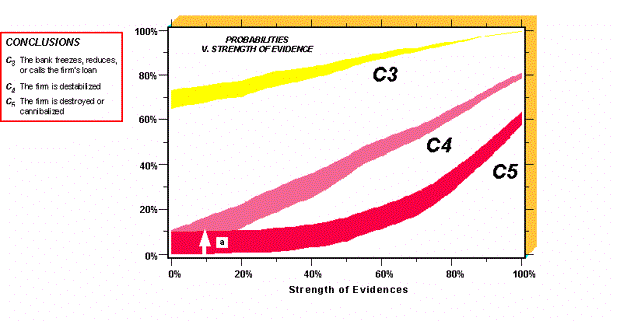 |
Plate 5-2
Specificity
Analysis: Effect of a 10% Reduction in the Specificity of the Rules on ConclusionsThe specificity
of a rule is the conditional probability P(-C|-E) that the conclusion is false when the
rule's combined input evidences are false. Three conclusions are considered:
C3: the bank
freezes, reduces, or calls the firm's loan
C4: the firm is destabilized
C5: the firm is destroyed or cannibalized.
A decrease in the specificity
of the rules increases the subjective probability of the rules (arrow a).
[Copyright
-- 1998 by MACROKNOW INC. All rights reserved.]
|
|
SENSITIVITY
OF THE SUBJECTIVE PROBABILITY
TO
THE VALIDITY OF THE RULES (TYPE 2 UNCERTAINTY) |
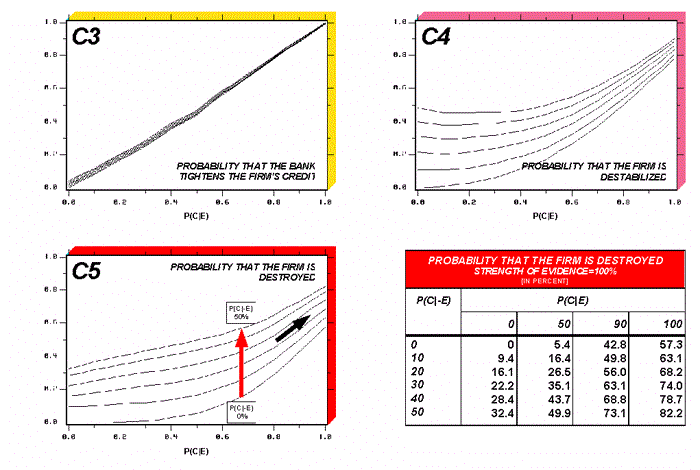 |
Plate 5-3
Sensitivity of
the Subjective Probability that the Firm is Destabilized and Destroyed, after the Bank
Tightens its Credit or Calls its Loan, to the Validity of the Rules (Type 2 Uncertainty)
-- 0%--P(C|E)--100% and 0%--P(C|-E)--50%. The Strength
of the Input Evidences is Assumed to be 100%.The subjective probabilities P(C3),
P(C4), and P(C5) are computed as a function of the validity of the
rules. The validity of the rules is parametrized as follows: P(C|E) is varied from 0% to
100% in 5% steps; and P(C|-E) is varied from 0% to 50% in 10% steps (or, equivalently
P(-C|-E) is varied from 100% to 50% in 10% steps). The subjective probabilities of
firm-related (Group 1) evidences are assumed to be fixed. The subjective probabilities of
environment-related (Group 2) evidences are assumed to be maximum: P(E1)=100%,
P(E2)=90%, and P(E3)=80%; P(E7)=90% and P(E8)=80%;
P(E11)=90% and P(E12)=80%. Coordinates in decimal form (1=100%);
tabulated data in percent.
[Copyright
-- 1998 by MACROKNOW INC. All rights reserved.]
|
|
SENSITIVITY OF THE SUBJECTIVE PROBABILITY
TO
THE STRENGTH OF THE EVIDENCES AND TO THE VALIDITY OF THE RULES |
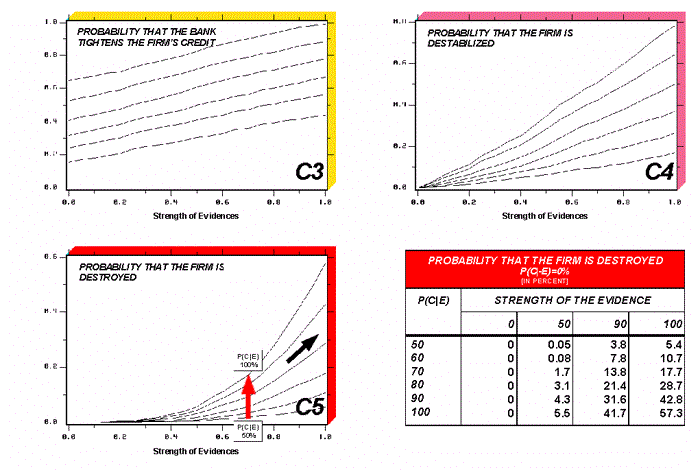 |
Plate 5-4
Sensitivity of
the Subjective Probability that the Firm is Destabilized and Destroyed, after the Bank
Tightens its Credit or Calls its Loan, to the Strength of the Evidences (Type 1
Uncertainty) and to the Validity of the
Rules (Type 2 Uncertainty)--50%--P(C|E)--100% and
P(C|-E)=0%The
subjective probabilities P(C3), P(C4), and P(C5) are
computed as a function of the strength of the input evidences (E1, E2,
and E3; E7 and E8; and E11 and E12).
The validity of the rules is parametrized as follows: P(C|-E) is fixed at 0% (or,
equivalently, P(-C|-E) is fixed at 100%); and P(C|E) is varied from 50% to 100% in 10%
steps. The subjective probabilities of firm-related (Group 1) evidences are assumed to be
fixed. The maximum subjective probabilities of environment-related (Group 2) evidences are
assumed to be as follows: P(E1)=100%, P(E2)=90%, and P(E3)=80%;
P(E7)=90% and P(E8)=80%; P(E11)=90% and P(E12)=80%.
Coordinates in decimal form (1=100%); tabulated data in percent.
[Copyright
-- 1998 by MACROKNOW INC. All rights reserved.]
|
|
SENSITIVITY OF THE SUBJECTIVE PROBABILITY
TO
THE STRENGTH OF THE EVIDENCES AND TO THE VALIDITY OF THE RULES |
 |
Plate 5-5
Sensitivity of
the Subjective Probability that the Firm is Destabilized and Destroyed, after the Bank
Tightens its Credit or Calls its Loan, to the Strength of the Evidences (Type 1
Uncertainty) and to the Validity of the Rules (Type 2 Uncertainty)--P(C|E)=100%
and 0%--P(C|-E)--50% The
subjective probabilities P(C3), P(C4), and P(C5) are
computed as a function of the strength of the input evidences (E1, E2,
and E3; E7 and E8; and E11 and E12).
The validity of the rules is parametrized as follows: P(C|E) is fixed at 100%; and P(C|-E)
is varied from 0% to 50% in 10% steps. The subjective probabilities of firm-related (Group
1) evidences are assumed to be fixed. The maximum subjective probabilities of
environment-related (Group 2) evidences are assumed to be as follows: P(E1)=100%,
P(E2)=90%, and P(E3)=80%; P(E7)=90% and P(E8)=80%;
P(E11)=90% and P(E12)=80%. Coordinates in decimal form (1=100%);
tabulated data in percent.
[Copyright
-- 1998 by MACROKNOW INC. All rights reserved.]
|
|
SENSITIVITY OF THE SUBJECTIVE PROBABILITY
TO
THE STRENGTH OF THE EVIDENCES AND TO THE VALIDITY OF THE RULES |
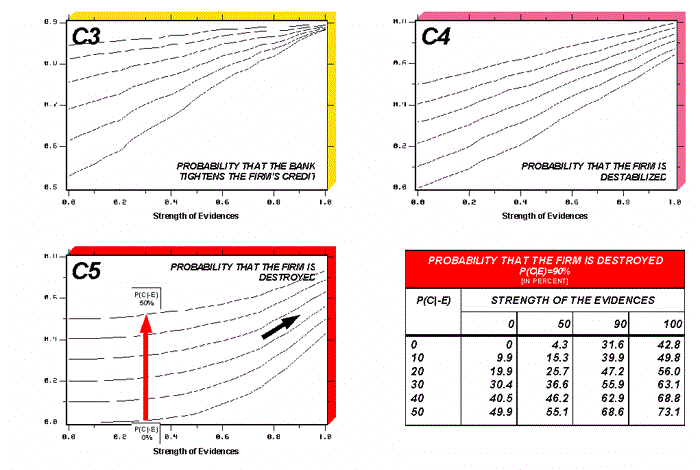 |
Plate 5-6
Sensitivity of
the Subjective Probability that the Firm is Destabilized and Destroyed, after the Bank
Tightens its Credit or Calls its Loan, to the Strength of the Evidences (Type 1
Uncertainty) and to the Validity of the Rules (Type 2 Uncertainty)--P(C|E)=90% and
0%--P(C|-E)--50% The subjective probabilities P(C3),
P(C4), and P(C5) are computed as a function of the strength of the
input evidences (E1, E2, and E3; E7 and E8;
and E11 and E12). The validity of the rules is parametrized as
follows: P(C|E) is fixed at 90%; and P(C|-E) is varied from 0% to 50% in 10% steps. The
subjective probabilities of firm-related (Group 1) evidences are assumed to be fixed. The
maximum subjective probabilities of environment-related (Group 2) evidences are assumed to
be as follows: P(E1)=100%, P(E2)=90%, and P(E3)=80%; P(E7)=90%
and P(E8)=80%; P(E11)=90% and P(E12)=80%. Coordinates in
decimal form (1=100%); tabulated data in percent.
[Copyright
-- 1998 by MACROKNOW INC. All rights reserved.]
|
|
SENSITIVITY OF THE SUBJECTIVE PROBABILITY
TO
THE STRENGTH OF THE EVIDENCES AND TO THE VALIDITY OF THE RULES |
 |
Plate 5-7
Sensitivity of
the Subjective Probability that the Firm is Destabilized and Destroyed, after the Bank
Tightens its Credit or Calls its Loan, to the Strength of the Evidences (Type 1
Uncertainty) and to the Validity of the Rules (Type 2 Uncertainty)--P(C|E)=80% and
0%--P(C|-E)--50% The subjective probabilities P(C3),
P(C4), and P(C5) are computed as a function of the strength of the
input evidences (E1, E2, and E3; E7 and E8;
and E11 and E12). The validity of the rules is parametrized as
follows: P(C|E) is fixed at 80%; and P(C|-E) is varied from 0% to 50% in 10% steps. The
subjective probabilities of firm-related (Group 1) evidences are assumed to be fixed. The
maximum subjective probabilities of environment-related (Group 2) evidences are assumed to
be as follows: P(E1)=100%, P(E2)=90%, and P(E3)=80%; P(E7)=90%
and P(E8)=80%; P(E11)=90% and P(E12)=80%. Coordinates in
decimal form (1=100%); tabulated data in percent.
[Copyright
-- 1998 by MACROKNOW INC. All rights reserved.]
|
|
SENSITIVITY OF THE SUBJECTIVE PROBABILITY
TO
THE STRENGTH OF THE EVIDENCES AND TO THE VALIDITY OF THE RULES |
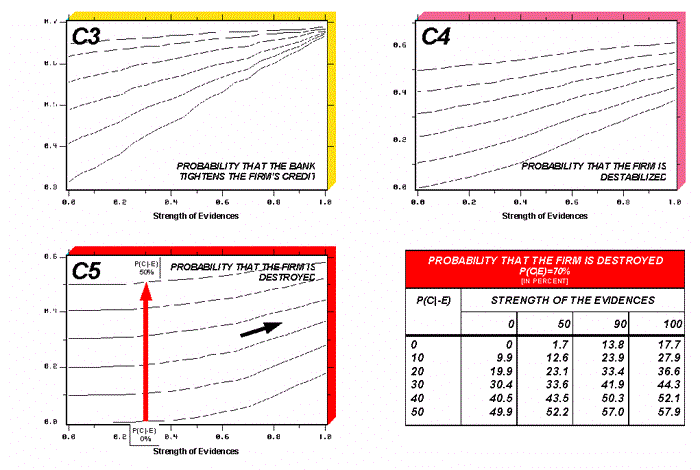 |
Plate 5-8
Sensitivity of
the Subjective Probability that the Firm is Destabilized and Destroyed, after the Bank
Tightens its Credit or Calls its Loan, to the Strength of the Evidences (Type 1
Uncertainty) and to the Validity of the Rules (Type 2 Uncertainty)--P(C|E)=70% and
0%--P(C|-E)--50% The subjective probabilities P(C3),
P(C4), and P(C5) are computed as a function of the strength of the
input evidences (E1, E2, and E3; E7 and E8;
and E11 and E12). The validity of the rules is parametrized as
follows: P(C|E) is fixed at 70%; and P(C|-E) is varied from 0% to 50% in 10% steps. The
subjective probabilities of firm-related (Group 1) evidences are assumed to be fixed. The
maximum subjective probabilities of environment-related (Group 2) evidences are assumed to
be as follows: P(E1)=100%, P(E2)=90%, and P(E3)=80%; P(E7)=90%
and P(E8)=80%; P(E11)=90% and P(E12)=80%. Coordinates in
decimal form (1=100%); tabulated data in percent.
[Copyright
-- 1998 by MACROKNOW INC. All rights reserved.]
|
|
SENSITIVITY OF THE SUBJECTIVE PROBABILITY
TO
THE STRENGTH OF THE EVIDENCES AND TO THE VALIDITY OF THE RULES |
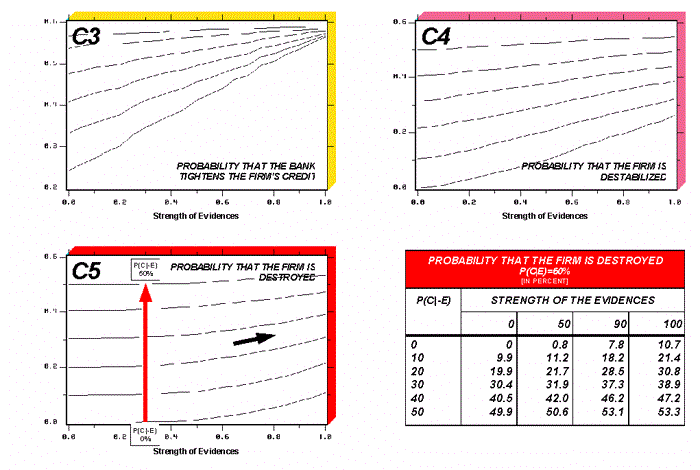 |
Plate 5-9
Sensitivity of
the Subjective Probability that the Firm is Destabilized and Destroyed, after the Bank
Tightens its Credit or Calls its Loan, to the Strength of the Evidences (Type 1
Uncertainty) and to the Validity of the Rules (Type 2 Uncertainty)--P(C|E)=60% and
0%--P(C|-E)--50% The subjective probabilities P(C3),
P(C4), and P(C5) are computed as a function of the strength of the
input evidences (E1, E2, and E3; E7 and E8;
and E11 and E12). The validity of the rules is parametrized as
follows: P(C|E) is fixed at 60%; and P(C|-E) is varied from 0% to 50% in 10% steps. The
subjective probabilities of firm-related (Group 1) evidences are assumed to be fixed. The
maximum subjective probabilities of environment-related (Group 2) evidences are assumed to
be as follows: P(E1)=100%, P(E2)=90%, and P(E3)=80%; P(E7)=90%
and P(E8)=80%; P(E11)=90% and P(E12)=80%. Coordinates in
decimal form (1=100%); tabulated data in percent.
[Copyright
-- 1998 by MACROKNOW INC. All rights reserved.]
|
|
SENSITIVITY OF THE SUBJECTIVE PROBABILITY
TO
THE STRENGTH OF THE EVIDENCES AND TO THE VALIDITY OF THE RULES |
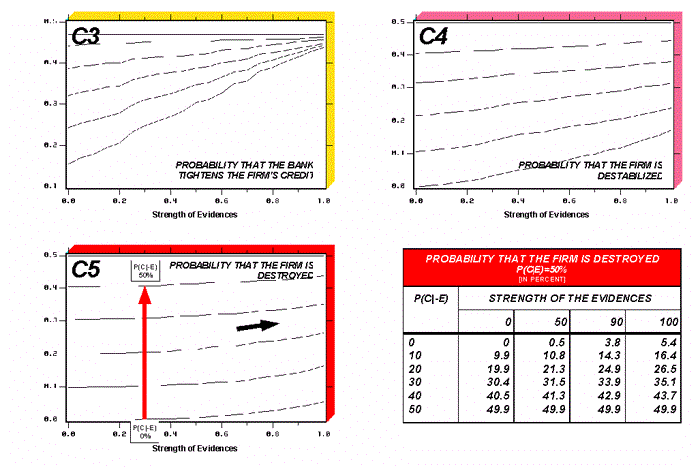 |
Plate
5-10 Sensitivity of
the Subjective Probability that the Firm is Destabilized and Destroyed, after the Bank
Tightens its Credit or Calls its Loan, to the Strength of the Evidences (Type 1
Uncertainty) and to the Validity of the Rules (Type 2 Uncertainty)--P(C|E)=50% and
0%--P(C|-E)--50% The subjective probabilities P(C3),
P(C4), and P(C5) are computed as a function of the strength of the
input evidences (E1, E2, and E3; E7 and E8;
and E11 and E12). The validity of the rules is parametrized as
follows: P(C|E) is fixed at 50%; and P(C|-E) is varied from 0% to 50% in 10% steps. The
subjective probabilities of firm-related (Group 1) evidences are assumed to be fixed. The
maximum subjective probabilities of environment-related (Group 2) evidences are assumed to
be as follows: P(E1)=100%, P(E2)=90%, and P(E3)=80%; P(E7)=90%
and P(E8)=80%; P(E11)=90% and P(E12)=80%. Coordinates in
decimal form (1=100%); tabulated data in percent.
[Copyright
-- 1998 by MACROKNOW INC. All rights reserved.]
|
|

Please read
carefully the
Terms and Conditions before accessing or
using this Macroknow Website.
Copyright © 1998-2008 by Edward E. Ayoub. All Rights Reserved.
Copyright © 1998-2008 by Macroknow Inc. All Rights Reserved.
Digital Art Copyright © 1998-2008 by Edward Thomas Matthew Ayoub. All Rights Reserved.
Macroknow™, Macroknow BookView™, Macroknow
i-Books™, Macroknow i-Services™, Macroknow WorldHood™, and the Macroknow
logos are trademarks of Macroknow Inc.
Other product, service, or company names mentioned in this
Web may be the trademarks of their respective owners.
MK-19980805-BIR.
Last modified:
2016-03-26 |
|









